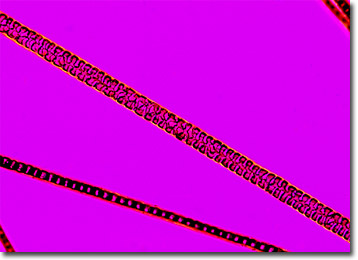Polarized Light Microscopy Digital Image Gallery
Chinchilla Hair
Chinchillas are small rodents found in nature inhabiting the high altitudes of the Andes mountain range in South America. The colonial animals are most active when the sun goes down, generally seeking shelter in rocky crevices during the day.

View a second image of Chinchilla Hair
Once abundant in their native habitat, chinchillas were almost hunted to extinction by those seeking to profit from the sell of their pelts. Unusually soft and plush, luxurious coats composed of chinchilla fur were in high demand by the upper classes in Europe during the eighteenth and nineteenth centuries, where they were first sent as gifts to royalty by the Spanish. As the popularity of chinchilla fur increased, populations of the rodents drastically decreased. However, in 1918, an American engineer named M. F. Chapman working in Chile bought one of the inquisitive animals from a native and became intrigued by it. He decided to capture as many of the rare rodents as possible in order to bring them back to the United States and establish a breeding population. With the help of 23 trappers over a three-year period he was able to only able to obtain 11 chinchillas from the harsh, mountainous terrain, one of which died during transport. It is from this remaining group that almost all domestic chinchillas alive today have descended.
In modern times, chinchillas are commonly kept as pets, although they are still popular in the fur industry as well. Virtually odorless, hardy, and unafflicted by fleas or other pests, these large-eared rodents may live for more than 20 years when properly cared for. They require little living space and may be safely kept in a small, clean cage, subsisting on food pellets, timothy hay, alfalfa, and water, though they also appreciate treats, such as dry oatmeal, apple slices, and sunflower seeds. Chinchillas do need regular exercise, however, to maintain good health and often enjoy cage wheels or running balls. Today, a variety of chinchillas are available in pet stores since both short- and long-tailed species exist and through selective breeding a variety of coat colorations have been developed.
